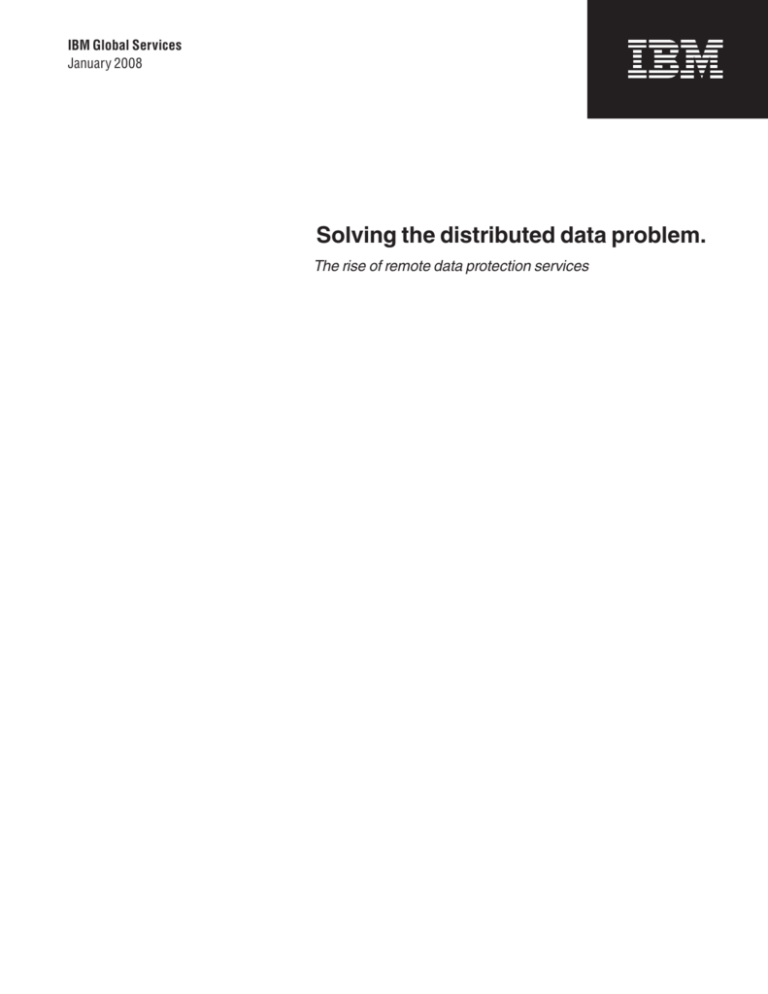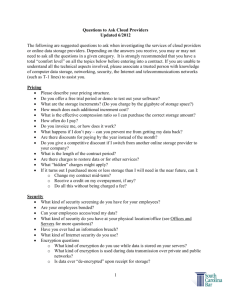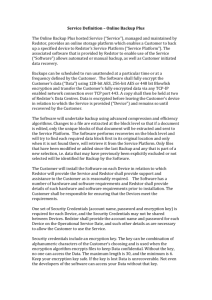
IBM Global Services
January 2008
Solving the distributed data problem.
The rise of remote data protection services
Solving the distributed data problem.
Page 2
Contents
2 Introduction
2 Threats to data security
3 Explosive data growth,
increased risk
Introduction
Companies need to reevaluate traditional methods of protecting branch office
and PC data such as tape backups and other localized do-it-yourself solutions.
The risks and potential costs of data loss, regulatory noncompliance and
business interruptions are serious and escalating. The scope of the problem
keeps growing as well, as more and more business-critical information is
generated and stored at remote sites and on end-user computing devices.
4 Tape backup: popular
and problematic.
4 The data center dilemma.
5 Protecting end-user data
5 A viable alternative
8 Benefits of the remote data
On demand data protection services represent a reasonably priced, workable
solution to a thorny problem. The market has matured, and service providers
are aggressively expanding their offerings to meet an ever more diverse set of
clients, making this an ideal time for companies to explore other options for
protecting their data.
protection service
10 Capabilities and options
for server data protection
11 Capabilities for desktop and
Threats to data security
Business data is on the move in more ways than one—and the result has been a
major IT headache.
laptop PC data protection
12 Summary
Threats to business continuance and data security keep growing—from hackers
and hurricanes to internal threats from disgruntled or careless employees.
Widespread disasters like Hurricane Katrina have shown all too clearly the
dangers and weaknesses of localized backup and recovery.
Failure to retain critical information in a safe, secure, easily recoverable
form has landed companies with multimillion dollar fines, not to mention
serious losses in revenue, customer goodwill, market position, credibility
and productivity.
Solving the distributed data problem.
Page 3
Highlights
Savvy corporate decision makers have recognized that to deal with these
challenges, they need to deploy a companywide data protection infrastructure.
However, doing so in house can be prohibitively expensive, not least because
more and more business information is being generated and stored outside the
data center and beyond central I T control—at branch offices and on employee
PCs and laptops. Protecting and managing this distributed data has become a
major expense and challenge for corporate IT staffs.
To solve the problem, a growing number of companies are turning to an entirely
different kind of solution: remote on demand data protection services.
Explosive data growth, increased risk
Managing and protecting
distributed data has become
a major challenge.
Businesses are responsible for protecting and securing an already extensive
and rapidly growing body of information. Managing and protecting that data
has become a major challenge for I T departments, as much of it is being
generated outside of the corporate data center.
Protecting data across a distributed enterprise constitutes a huge and growing
I T expense. Companies cannot afford to put the problem on the back burner:
The dangers and potential costs are much too high.
Companies of all sizes are
expanding to include more
remote or branch locations.
The problem is likely to worsen over the next few years for companies of all
sizes. Data becomes less centralized as businesses expand to include more
remote or branch locations. Factors driving this trend include offshoring of
business processes, supply chain integration, expansion into key regions for
competitive purposes, mergers and acquisitions and market globalization.
Branch offices often lack adequate onsite I T support. With limited resources
to focus on backup and recovery, properly managing and protecting data can
be difficult.
Solving the distributed data problem.
Page 4
Tape backup: popular and problematic.
Highlights
Unencrypted tapes are a
security risk, as they are
easily lost or stolen.
For sites with little or no local I T support, tape backup has become the de
facto data protection strategy. However, this approach is unsatisfactory
because it tends to be:
• Unreliable and haphazard, posing the risk of being found noncompliant
with federal, state, securities and business continuance mandates for
companies of all sizes.
• Difficult to centrally manage, as I T staffs may not have a way to monitor
remote operations to ensure that backups take place and are successful.
• Risky, with tapes easily lost or stolen, particularly in transit, as when they
are being moved to a secure offsite facility.
• Capital and I T resource intensive, requiring servers, tapes, disk drives and
backup software at every site.
• Slow and cumbersome, hindering the realization of recovery point objectives
(RPOs) and recovery time objectives (RTOs).
• Unable to protect companies from serious data loss, lost productivity and
regulatory fines that result from inadequate data protection.
The data center dilemma.
Backing up remote sites can
be expensive and complex.
Some companies are backing up remote sites to data center servers. However,
this solution can be both expensive to deploy and complex to administer.
Each remote site must be equipped with a networked storage device and
replication software. Network costs increase as well, since periodic server
backups tend to hog wide area network (WAN) and local area network (LAN)
bandwidth, potentially interfering with business-critical transmissions and
end-user productivity.
Solving the distributed data problem.
Page 5
Protecting end-user data
Highlights
Companies need to protect
information that is being
Branch offices constitute only one piece of the distributed data protection
picture. Companies also need to protect the information that is being generated,
downloaded and shared by a rapidly growing horde of PCs and mobile
computing devices.
generated remotely.
Today’s mobile workforce generates massive amounts of data, often many miles
away from corporate headquarters and I T control. Protecting and securing
this critical and sensitive information, which includes client records and
intellectual property, becomes the sole responsibility of these time-challenged
and often nontechnical end users.
The need to protect this data is urgent: Computers can be stolen, suffer hard
disk failures or become infected with viruses. While remote PC backup
products are available, they tend to be bandwidth and CPU intensive, slowing
down application and network response times, annoying users and negatively
impacting productivity.
A viable alternative
This situation poses a serious dilemma for many corporate I T departments.
They realize that their current distributed data protection setup is inadequate
and that a centralized infrastructure is the best way to go but lack the resources
to deploy and manage it in house.
An on demand distributed data
protection service can provide
increased reliability and security.
Fortunately, there is a better way to go: an on demand distributed data
protection service that automatically backs up offsite PCs and servers with
greater reliability and security, virtually anywhere on a client’s Internet
Protocol (IP) network.
Solving the distributed data problem.
Page 6
Highlights
Remote on demand services have
become the data protection solution
On demand data protection services offer hardware and software, centralized
management and reporting, 24 7 monitoring and management, third-party
hosting and offsite Tier 1 data facilities. Remote on demand services have
become the data protection solution of choice for a growing number of
companies of virtually all sizes.
of choice for many companies.
The on demand data protection service model offers several major advantages
over a do-it-yourself, in-house solution.
Evaluating ROI
When evaluating ROI for a service-based protection solution, a company needs
to take into account all of the relevant costs that would accrue from deploying
a comparable solution in house. An analysis should take into account probable
increases in these costs over time, as the installation grows to meet increased
demand. They include:
• Capital costs, including storage network hardware, software and longdistance connections, as well as building facilities for a primary, and
possibly a backup, data center
• Labor costs, including training existing staff and hiring new technicians to
install, maintain and manage the new installation.
• Hidden costs that result from insufficiently protected data and systems
(including, but not limited to, loss of I T and end-user productivity, lost
revenue and customer goodwill and regulatory fines).
On demand services may provide
significant returns in both capital
and labor costs.
On demand services may provide significant returns in all of the above cost
areas. Equipment, software and technical support are provided as part of the
service, helping to save the client on both capital and labor costs. The client
pays by the month, according to how much data needs to be backed up.
Solving the distributed data problem.
Page 7
Highlights
The right service provider can
offer a level of distributed data
protection that most companies
cannot afford on their own.
The on demand model helps IT
administrators predict and plan for
future costs far more accurately.
High service levels, enhanced continuity.
What is most important is that the right service provider can help guard against
the high costs of data loss by providing a level of distributed data protection
that most companies cannot afford on their own. I T managers can rest easier if
they feel that backups can take place on schedule across all branch offices and
designated PCs and servers, and that RPOs and RTOs will likely be addressed.
Data can be housed in the service provider’s remote disaster-recovery facility,
increasing business continuity if a disaster should take out a branch office or
even headquarters.
Scalability
For most corporate IT staffs, keeping up with a company’s growing data
protection demands is a constant struggle as well as a major expense. On
demand services have the built-in redundancy, capacity and flexibility to
help address the needs of companies of nearly any size, and to scale up or
down relatively quickly and smoothly when those needs change. Paying only
for services used, a company no longer has the expense of purchasing and
maintaining equipment that is often either under- or overutilized. As a further
benefit, the on demand model helps IT administrators predict and plan for
future costs far more accurately.
Established solutions demonstrate efficacy of the on demand model.
One such managed on demand data protection solution is IBM Information
Protection Services—remote data protection service.
The remote data protection service
helps companies protect data on
servers, PCs and laptops across
the organization.
This service helps companies protect data on servers, PCs and laptops across
the organization and from virtually any location. Data is automatically backed
up via the client’s existing network to our security-rich offsite data centers.
Solving the distributed data problem.
Page 8
Highlights
Daily backups are intended to be fast,
cost-effective and convenient to
provide consistent data protection.
The remote data protection service is a pay-as-you-go subscription
service designed to make data protection costs highly predictable and
reasonably priced for clients. The service includes the hardware, software
and operational support needed to quickly and more easily implement an
effective data protection strategy. This approach helps eliminate the research,
implementation, hiring and training costs of launching an in-house solution—
while accelerating service delivery.
Data is backed up automatically on a daily basis, facilitating extremely fast
performance with fewer demands on clients’ networks. It is intended to be a
fast, cost-effective and convenient way to provide consistent data protection
across an organization’s servers, PCs and locations, while reducing the need
to increase network investment.
The service can be cost-effective for businesses of nearly any size—from large
global enterprises with multiple sites to small and midsize businesses (SMBs)—
because clients only pay for the amount of data they back up.
Benefits of the remote data protection service
Clients can redeploy personnel to
potentially lower their backup and
recovery management costs.
• Increased potential for cost savings and ROI. Equipment and support
are provided for clients at disaster-resistant data centers, reducing the need
for capital investments in hardware or software. Pricing is based on the
amount of data clients protect, allowing them to control their costs because
capacity utilization is improved. And because critical data protection
operations are automated, clients can redeploy personnel to other projects
and potentially lower their backup and recovery management costs.
• Offsite data protection. The remote data protection service supports
reliable and efficient automated offsite daily backups of server and PC data for business continuity and disaster recovery, virtually anywhere data resides (branch offices, mobile devices, etc.).
• Higher service levels and increased continuity. Backup and recovery of vital business data are supported and managed 24 hours a day, 365 days
a year.
Solving the distributed data problem.
Page 9
Highlights
With the remote data protection
service, protecting and accessing
data can be extremely efficient.
Our disaster-resistant centers are
designed to protect client data from
even the most extreme natural events.
• Nonintrusive, scalable backups. Advanced technology reduces the
bandwidth required to protect client data, helping to enhance computer
and network performance. The remote data protection service includes a
high-capacity infrastructure that addresses a client’s changing needs as the
amount of data grows.
• Greater ease of use. Intuitive applications and Web portal interfaces make
it easier for personnel to back up and restore data automatically with a few
mouse clicks.
• Faster backups and recovery with no tape. Tape solutions can be
slow, frustrating and unreliable. With the remote data protection service,
protecting and accessing data can be extremely efficient.
• Flexible retention policies and long-term archiving. The remote data
protection service allows clients to define specific time-based data retention
policies that match their business needs—from daily, weekly and monthly,
to yearly retention options for compliance efforts. And the remote data
protection service also offers the option to archive everything to tape for
long-term retention.
• Security and compliance. The remote data protection service features
128-bit Advanced Encryption Standard (A E S) encryption, which tends to be more secure because it helps ensure that only authorized users can
access data. In addition, our disaster-resistant centers are designed to
protect client data from even the most extreme natural events, which is one
of the safest alternatives.
• Comprehensive platform support. The remote data protection service
features power-ful platform support for Microsoft® Windows®, UNIX® and
Linux® operating systems as well as leading databases such as Oracle,
Microsoft Exchange and SQL and virtual machines from VM ware,
Microsoft and Sun.
Solving the distributed data problem.
Page 10
Capabilities and options for server data protection
Highlights
Rapid onsite data recovery helps
meet increasingly stringent RTOs.
Remote data protection Onsite Appliance option for server data protection
The remote data protection Onsite Appliance option offers rapid onsite data
recovery to help address increasingly stringent RTOs. This option is delivered
through installation of a preconfigured storage appliance on the client’s LAN,
allowing a failed server to be recovered in hours rather than days.
Remote data protection Bare Metal Recovery option for servers
The remote data protection Bare Metal Recovery option is a managed and
automated service that helps clients rapidly complete a “bare metal” recovery
of their server operating systems and applications up to 80 percent faster than
traditional methods allow. With this option, clients have a more reliable and
cost-effective tool for bringing their business back online quickly.
Remote data protection Quickstart option for servers
The remote data protection Quickstart option is an onsite, security-rich
data protection option for large enterprise branch offices or SMBs that can
dramatically reduce the time and bandwidth typically required to complete
an initial backup over the Internet. This is done by collecting a data copy
locally and then shipping the data to the provider’s service platform, where
it is imported. Once the data is on the IBM service platform, incremental
backups completed over the Internet can be performed in a fraction of the
time typically required.
To help reduce recovery time,
an appliance with client data
can be quick-shipped to the
client’s location.
Remote data protection Quickrestore option for servers
The remote data protection Quickrestore option is a security-rich disaster
recovery option for large enterprise branch offices or SMBs. In the event of a
server or site disaster, an appliance with client data can be quick-shipped to
the client’s disaster recovery or original location to help reduce recovery time.
Large server restore time can be cut substantially by reducing the need for large
restores to be sent across the Internet.
Solving the distributed data problem.
Page 11
Capabilities for desktop and laptop PC data protection
Highlights
Data is automatically backed up
on a daily basis.
Data can generally be backed up
and restored at any time.
For desktop and laptop PC data protection, the remote data protection service
offers a managed online data backup and recovery service that addresses
critical data protection, business continuity and financial requirements for
both large enterprises and SMBs.
Data from a client’s desktops and laptops is automatically backed up on a daily
basis through the client’s existing network connection to a security-rich offsite
storage facility. Mission-critical data is centrally managed, more securely
protected and more easily recoverable when it is needed.
Operationally, the remote data protection service is designed to be a fast and
highly efficient solution. By transmitting only data that has changed since
the last backup, the remote data protection service reduces the bandwidth
required to perform these operations. This helps lessen the impact on
individual computer and network performance, allowing clients’ staff to
continue working during the backup process. Data can generally be backed
up and restored by individual users at any time, without I T support, using the
intuitive remote data protection user interface. Users log in to the application
and simply select the data they would like to back up or restore. With the ability
to select single files or entire folders, users can typically retrieve different
versions of their files from any backup performed during the previous 30 days.
Summary
Companies need to reevaluate traditional methods of protecting branch office
and PC data such as tape backups and other localized do-it-yourself solutions.
The risks and potential costs of data loss, regulatory noncompliance and
business interruptions are serious and escalating. And the scope of the
problem keeps growing, as more and more business-critical information is
generated and stored at remote sites and on end-user computing devices.
The remote data protection service can help to guard against the high
costs of data loss by providing a level of distributed data protection that
most companies cannot afford on their own. With several service options,
on demand data protection services can be a reasonably priced solution for
companies of virtually any size.
For more information
To learn more about IBM Information Protection Services—remote data
protection service, contact your IBM representative, or visit:
ibm.com /services/continuity
© Copyright IBM Corporation 2008
IBM Global Services
Route 100
Somers, NY 10589
U.S.A.
Produced in the United States of America
01-08
All Rights Reserved
IBM and the IBM logo are trade-marks or registered
trademarks of International Business Machines
Corporation in the United States, other countries,
or both.
Microsoft and Windows are trademarks of Microsoft
Corporation in the United States, other countries,
or both.
UNIX is a registered trademark of The Open Group in
the United States and other countries.
Linux is a registered trademark of Linus Torvalds in the
United States, other countries, or both.
Other company, product and service names may be
trademarks or service marks of others.
References in this publication to IBM products or
services do not imply that IBM intends to make them
available in all countries in which IBM operates.
BUW-03002-USEN-02









